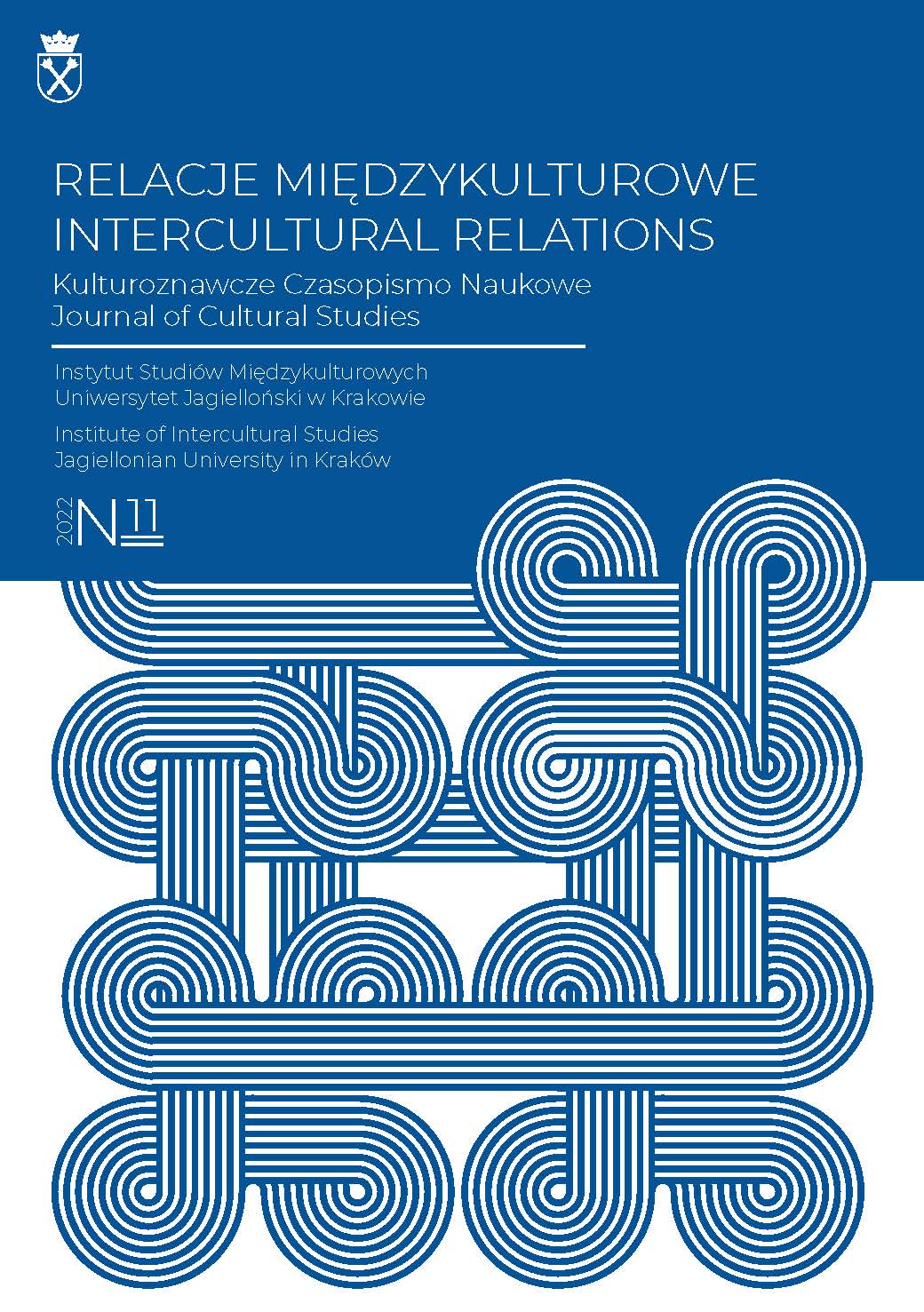Emocje, kontekst sytuacyjny i poznanie społeczne
DOI:
https://doi.org/10.12797/RM.01.2022.11.01Keywords:
emotions, mimic expression, social recognitionAbstract
EMOTIONS, SITUATION CONTEXT AND SOCIAL RECOGNITION
The article presents definition of emotional states and the problem of a mimic expression of emotions, which is very important for social relations. It discusses the determinants of expression, the cultural rules of regulating and revealing emotional states, and the importance of the situational context for the reception of a mimic expression. Moreover, a complex cognitive process connected with reading the emotional states of others was presented, in which the recipient makes inferences about the social world, the way the observed person perceives the world, as well as his/her properties and attributes.
References
Clore, G. C. 1999. Dlaczego emocje są zawsze świadome. W: P. Ekman, R. J. Davidson (red.), Natura emocji. Podstawowe zagadnienia (B. Wojciszke, tłum.), (s. 242–247). Gdańsk: GWP.
Damasio, A. R. 1999. Błąd Kartezjusza. Emocje, rozum i ludzki mózg (M. Karpiński, tłum.), Poznań: Dom Wydawniczy Rebis.
Davidson, R. J. 1999. O emocji, nastroju i innych pojęciach afektywnych. W: P. Ekman, R. J. Davidson (red.), Natura emocji. Podstawowe zagadnienia (B. Wojciszke, tłum.) (s. 50–53). Gdańsk: GWP. DOI: https://doi.org/10.1093/res/50.200.524
Ekman, P. 1999. Facial Expressions. W: T. Dalgleish, M. Power (red.), Handbook of Cognition and Emotion (s. 301–320). Chichester: John Wiley & Sons. DOI: https://doi.org/10.1002/0470013494.ch16
Ekman, P., Friesen, W. V. 1971. Constants Across Cultures in the Face of Emotions, „Journal of Personality and Social Psychology”, 29, 124–129, https://doi.org/10.1037/h0030377. DOI: https://doi.org/10.1037/h0030377
Ekman, P., Friesen, W. V., O’Sullivan, M., Chan, A., Diacoyani-Tarlatzis, I., Heider, K. i in. 1987.
Universals and Cultural Differences in the Judgments of Facial Expression of Emotion, „Journal of Personality and Social Psychology”, 53, 712–717, https://doi.org/10.1037/0022-3514.53.4.712. DOI: https://doi.org/10.1037/0022-3514.53.4.712
Erbas, Y., Sels, L., Ceulemans, E., Kuppens. P. 2016. Feeling Me, Feeling You, „Social Psychological and Personality Science”, 7(3), 240–247, https://doi.org/10.1177/1948550616633504. DOI: https://doi.org/10.1177/1948550616633504
Fischer, A. H., Pauw, L. S., Manstead, A. S. 2019. Emotion Recognition as a Social Act: The Role of the Expresser-Observer Relationship in Recognizing Emotions. W: U. Hess, S. Hareli (red.), The Social Nature of Emotion Expression: What Emotions Can Tell Us about the World, Springer Nature Switzerland AG, https://doi.org/10.1007/978-3-030-32968-6_2. DOI: https://doi.org/10.1007/978-3-030-32968-6_2
Gratch, J., de Melo, C. S. 2019. Inferring Intentions from Emotion Expressions in Social Decision Making. W: U. Hess, S. Hareli (red.), The Social Nature of Emotion Expression.
What Emotions Can Tell Us About the World ( s. 1 41–160). Cham: Springer, https://doi.org/10.1007/978-3-030-32968-6_8. DOI: https://doi.org/10.1007/978-3-030-32968-6_8
Greenaway, K., Kalokerinos, E., Murphy, S., McIlroy, C. 2018. Winners Are Grinners: Expressing Authentic Positive Emotion Enhances Status in Performance Contexts, „Journal of Experimental Social Psychology”, 78, 168–180, https://doi.org/10.1016/j.jesp.2018.03.013. DOI: https://doi.org/10.1016/j.jesp.2018.03.013
Gross, J. J. 1998. The Emerging Field of Emotion Regulation: An Integrative Review, „Review of General Psychology”, 2, 271–299, https://doi.org/10.1037/1089-2680.2.3.271. DOI: https://doi.org/10.1037/1089-2680.2.3.271
Hall, J. A., Coats, E. J., LeBeau, L. S. 2005. Non-verbal Behavior and the Vertical Dimension of Social Relations. A Meta-Analysis, ,,Psychological Bulletin”, 131(6), 898–924, https://doi.org/10.1037/0033-2909.131.6.898. DOI: https://doi.org/10.1037/0033-2909.131.6.898
Hareli, S., Elkabetz, S., Hess, U. 2019. The Use of Emotions to Infer Norms and Standards. W: U. Hess, S. Hareli (red.), The Social Nature of Emotion Expression: What Emotions Can Tell Us About the World (s. 199–208). Cham: Springer, https://doi.org/10.1007/978-3-030-32968-6_11. DOI: https://doi.org/10.1007/978-3-030-32968-6_11
Hareli, S., Hess, U. 2010. What Emotional Reactions Can Tell Us About the Nature of Others: An Appraisal Perspective on Person Perception, „Cognition and Emotion”, 24(1), 128–140, https://doi.org/10.1080/02699930802613828. DOI: https://doi.org/10.1080/02699930802613828
Hess, U., Hareli, S. 2018. On the Malleability of the Meaning of Contexts: The Influence of Another Person’s Emotion Expressions on Situation Perception, „Cognition and Emotion”, 32, 185–191, https://doi.org/10.1080/02699931.2016.1269725. DOI: https://doi.org/10.1080/02699931.2016.1269725
Hess, U., Hareli, S. 2019. The Emotion-Based Inferences in Context (EBIC) Model. W: U. Hess, S. Hareli (red.), The Social Nature of Emotion Expression: What Emotions Can Tell Us About the World (s. 1–6). Cham: Springer, https://doi.org/10.1007/978-3-030-32968-6_1. DOI: https://doi.org/10.1007/978-3-030-32968-6_1
Israelashvili, J., Oosterwijk, S., Sauter, D. A., Fischer, A. H. 2019. Knowing Me, Knowing You: Emotion Differentiation in Oneself is Associated with Recognition of Others’ Emotions, „Cognition and Emotion”, 33(7), 1461–1471, https://doi.org/10.1080/02699931.2019.1577221. DOI: https://doi.org/10.1080/02699931.2019.1577221
Izard, C. E. 1992. Basic Emotions, Relations Among Emotions and Emotion – Cognition Relation, „Psychological Review”, 99, 561–565, https://doi.org/10.1037/0033-295X.99.3.561. DOI: https://doi.org/10.1037/0033-295X.99.3.561
Kalokerinos, E., Greenaway, K., Pedder, D., Margetts, E. 2014. Don’t Grin When You Win: The Social Costs of Positive Emotion Expression in Performance Situations, „Emotion”, 14(1), 180–186, https://doi.org/10.1037/a0034442. DOI: https://doi.org/10.1037/a0034442
Łosiak, W. 2007. Psychologia emocji, Warszawa: Wydawnictwa Akademickie i Profesjonalne.
Matsumoto, D., Yoo, S. H., Hirayama, S., Petrova, G. 2005. Development and Validation of a Measure of Display Rule Knowledge: The Display Rule Assessment Inventory, „Emotion”, 5, 23–40, https://doi.org/10.1037/1528-3542.5.1.23. DOI: https://doi.org/10.1037/1528-3542.5.1.23
Mayer, J., Salovey, P., Caruso, D. 2004. Emotional Intelligence: Theory, Findings and Implications, „Psychological Inquiry”, 15(3), 197–215, https://doi.org/10.1207/s15327965pli1503_02. DOI: https://doi.org/10.1207/s15327965pli1503_02
Niedenthal, P. M., Brauer, M. 2012. Social Functionality of Human Emotion, „Annual Review of Psychology”, 63, 259–285, https://doi.org/10.1146/annurev.psych.121208.131605. DOI: https://doi.org/10.1146/annurev.psych.121208.131605
Oatley, K., Jenkins, J. M. 2003. Zrozumieć emocje, Warszawa: Wydawnictwo Naukowe PWN.
Rychlowska, M., Manstead, A. S., van der Schalk, J. 2019. The Many Faces of Smile. W: U. Hess, S. Hareli (red.), The Social Nature of Emotion Expression: What Emotions Can Tell Us About the World (s. 227–246). Cham: Springer, https://doi.org/10.1007/978-3-030-32968-6_13. DOI: https://doi.org/10.1007/978-3-030-32968-6_13
Smidt, K. E., Suvak, M. K. 2015. A Brief, But Nuanced, Review of Emotional Granularity and Emotion Differentiation Research, „Current Opinion in Psychology”, 3, 48–51, https://doi.org/10.1016/j.copsyc.2015.02.007. DOI: https://doi.org/10.1016/j.copsyc.2015.02.007
Wciórka, J. 2004. Psychopatologia ogólna – objawy i zespoły zaburzeń psychicznych. W: Bilikiewicz, T. (red.), Psychiatria. Podręcznik dla studentów medycyny (s. 56–107). Warszawa: Wydawnictwo Lekarskie PZWL.
Downloads
Published
Issue
Section
License

This work is licensed under a Creative Commons Attribution-NonCommercial-NoDerivatives 4.0 International License.






